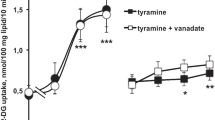Abstract
Numerous synthetic agonists selectively stimulate β3-adrenoceptors (ARs). The endogenous catecholamines, noradrenaline and adrenaline, however, stimulate all the β-AR subtypes, and no selective physiological agonist for β3-ARs has been described so far. The aim of this study was to investigate whether any naturally occurring amine can stimulate selectively β3-ARs. Since activation of lipolysis is a well-known β-adrenergic function, the efficacy and potency of various biogenic amines were compared with those of noradrenaline, isoprenaline, and β3-AR agonists 4-(-{[2-hydroxy-(3-chlorophenyl)ethyl]-amino}propyl)phenoxyacetate (BRL 37,344) and (R,R)-5-(2-{[2-(3-chlorophenyl)-2-hydroxyethyl]-amino}propyl)-1,3-benzo-dioxole-2,2-dicarboxylate (CL 316,243) by testing their lipolytic action in white fat cells. Five mammalian species were studied: rat, hamster and dog, in which selective β3-AR agonists act as full lipolytic agents, and guinea-pigs and humans, in which β3-AR agonists are less potent activators of lipolysis.
Several biogenic amines were inefficient (e.g. dopamine, tyramine and β-phenylethylamine) while others (synephrine, phenylethanolamine, epinine) were partially active in stimulating lipolysis in all species studied. Their actions were inhibited by all the β-AR antagonists tested, including those selective for β1- or β2-ARs. Octopamine was the only amine fully stimulating lipolysis in rat, hamster and dog fat cells, while inefficient in guinea-pig or human fat cells, like the β3-AR agonists. In rat white fat cells, β-AR antagonists inhibited the lipolytic effect of octopamine with a relative order of potency very similar to that observed against CL 316,243. Competitive antagonism of octopamine effect resulted in the following apparent pA 2 [–log(IC50), where IC50 is the antagonist concentration eliciting half-maximal inhibition] values: 7.77 (bupranolol), 6.48 [3-(2-ethylphenoxy)-1[(1 S)-1,2,3,4-tetrahydronaphth-1-ylaminol]-(2S)2-propanol oxalate, SR 59230A, a β3-selective antagonist], 6.30 [erythro-d,l-1(7-lethylindan-4-yloxy)-3-isopropylamino-butan-2-ol, ICI 118,551, a β2-selective antagonist] and 4.71 [(±)-[2-(3-carbomyl-4-hydroxyphenoxy)-ethylamino]-3-[4-(1-methyl-4-trifluoromethyl-2-imi-dazolyl)-phenoxy]2-propanolmethane sulphonate, CGP 20712A, a β1-selective antagonist]. Octopamine had other properties in common with β3-AR agonists: stimulation of oxygen consumption in rat brown fat cells and very low affinity in displacing [3H]CGP 12,177 binding to β1- or β2-ARs in dog and rat adipocyte membranes. In Chinese hamster ovary (CHO) cells expressing human β3-ARs, octopamine inhibited [125I]ICYP binding with only twofold less affinity than noradrenaline while it exhibited an affinity around 200-fold lower than noradrenaline in CHO cells expressing human β1- or β2-ARs. These data suggest that, among the biogenic amines metabolically related to catecholamines, octopamine can be considered as the most selective for β3-ARs.
Similar content being viewed by others
Author information
Authors and Affiliations
Additional information
Received: 16 November 1998 / Accepted: 13 January 1999
Rights and permissions
About this article
Cite this article
Carpéné, C., Galitzky, J., Fontana, E. et al. Selective activation of β3-adrenoceptors by octopamine: comparative studies in mammalian fat cells. Naunyn-Schmiedeberg's Arch Pharmacol 359, 310–321 (1999). https://doi.org/10.1007/PL00005357
Issue Date:
DOI: https://doi.org/10.1007/PL00005357




